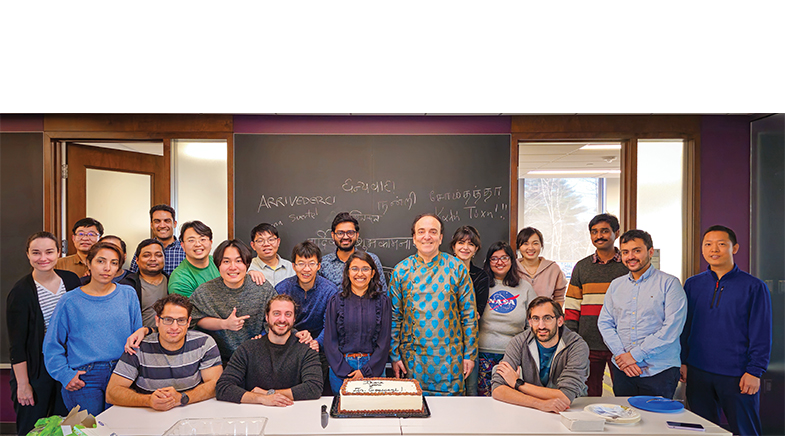Going cuckoo!
-
- from Shaastra :: vol 03 issue 10 :: Nov 2024

The natural and cultural history of a mesmerising bird.
Few birds have obsessed us as much — and for as long — as the cuckoo. Since way back in the day, when Aristotle and Pliny the Elder were giving gyan (often nonsensical, but cutting edge then) about the natural world, the cuckoo, with its lunatic eyes, hawk-like camouflage, distinctive calls, amazing punctuality, and most of all its allegedly deplorable habit of jettisoning its eggs in the nests of other birds, has mesmerised us. Much has been written, in prose and (often sickly lyrical) poetry; finger-wagging morals have been thrust into our faces; music has been composed; and its behaviour has been studied, interpreted and misinterpreted in itsy-bitsy detail.

In Cuckoo, Cynthia Chris explores just how so. Be it literature, legend, superstition, mythology, agriculture, or (Western classical) music, this slim book delves into it all. She deals with the bird's physical attributes, the migratory punctuality it maintains (heralding spring in the Western world), and, most of all, its propensity towards being a brood parasite — and the evolutionary advantage this kind of behaviour might hold (not all cuckoos have this seemingly irresponsible attitude towards parenthood). But this is what seems to excite us the most: imagine doing hanky-panky and dropping your eggs in the nest of some innocent little warbler so that you can go on gloriously philandering... And lay eggs that hatch into demonic young who toss the original eggs out of the nest and grow so large on their tiny foster parents' largesse that they could well swallow them in a single gulp!
Imagine doing hanky-panky and dropping your eggs in the nest of some innocent little warbler so that you can go on gloriously philandering...
Chris has delved deep into our relationship with the bird, and the book is replete with references and illustrations depicting it. An enormous amount of literature appears to have been trawled through in which there is pathos, humour, romance, and tragedy. And also some most unscientific character assassination by science writers, one of whom called cuckoos "even bigger assholes than we realized".
SOME GEMS, AND MORE
Some of the superstitions linked to the cuckoo make one wonder who the real cuckoo is. In France, Chris tells us, jingling coins in your pocket while hearing a cuckoo means your financial security is assured! In Scotland, when the bird calls, you remove your shoes and socks and check for "errant hair", for you will marry someone with hair the same colour as that stuck on your foot. There are several other such gems.
The book is neatly divided into chapters delving into various aspects of the cuckoo's life – and its relationship with us. After learning what a cuckoo is, we get to the juicy chapter 'Dear Cuckold', followed by 'Myths and Madness' surrounding the bird. I did get a bit cross-eyed while going through the section discussing the bird's contribution towards Western classical music, where such giants as Vivaldi and Handel have been inspired by its calls (the clarinet is the bird's instrument).

As for Indian cuckoos, there is a brief mention of the notorious brain-fever bird or common hawk-cuckoo (which drives birders nuts by calling from the deepest shade while they tramp around in the midday summer heat looking for it) and of the swashbuckling Jacobin cuckoo. This one, the chãtaka bird, is considered the symbol of purest love and is said to drink "only the purest raindrops that fall from the sky"! I knew its arrival was meant to herald the monsoon, apparently flying over ahead of it across the Arabian Sea from Africa, but not this.
Surprisingly, there is no mention of the koel (also a member of the cuckoo clan) which, with its partner, fools the most intelligent bird of them all — the crow. The gentleman koel is glossy black, and resembles the birds it scams; the lady is in camouflage commando colours, which help her do the deed without detection. The gentleman flies over what will soon be the cuckoo's nest — the crows' residence — inviting chase. While that is on, the lady slips in and lays her eggs in the unguarded nest — and then gives her partner a 'done deal!' call. Nor is there any mention that the Indian cuckoo is often found sitting on a telegraph wire, dolefully calling out for "One more bottle! One more bottle! One more bottle!"
Ranjit Lal is a columnist and an author who writes especially for children and for adults who are children.
Have a
story idea?
Tell us.
Do you have a recent research paper or an idea for a science/technology-themed article that you'd like to tell us about?
GET IN TOUCH














